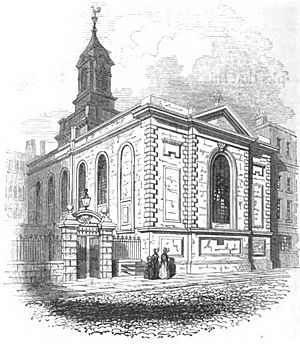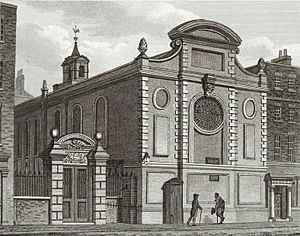St Stephen Coleman Street facts for kids
Quick facts for kids St. Stephen Coleman Street |
|
|---|---|
 |
|
| Location | Coleman Street and Gresham Street, London |
| Country | United Kingdom |
| Denomination | Church of England |
| Architecture | |
| Architect(s) | Christopher Wren |
| Style | Baroque |
| Demolished | 1940 |
St. Stephen's Church, Coleman Street, was an old church in the heart of London. People also called it "St Stephen's in the Jewry". It stood at the corner of Coleman Street and what is now Gresham Street. The church was first mentioned way back in the 1100s.
For a long time, it was sometimes a main church for a local area (a parish church) and sometimes a smaller church helping out a bigger one nearby (a chapel of ease). It became a full parish church again in 1456.
The original church was burned down in the Great Fire of London in 1666. A famous architect, Sir Christopher Wren, designed a new one. Sadly, this second church was destroyed by bombs in 1940 during World War II and was never rebuilt.
St. Stephen's was one of two churches in London named after Saint Stephen, an early Christian martyr. Coleman Street got its name from the people who used to burn charcoal there. Some thought the church was once a synagogue because it was in a part of London where many Jewish people lived, but this was not true.
Contents
The First Church: Medieval Times
The oldest mention of St. Stephen's Church is from the time of King John. This was around the late 1100s or early 1200s.
Around 1400, the church was known as a chapel of ease for St. Olave Old Jewry. This meant it was a smaller church that helped the main parish church. However, it became a full parish church again in the mid-1400s.
In 1431, a man named John Sokelyng left money to St. Stephen's. He owned a brewery nearby. He asked that a special church service (a Mass) be held every year on the day he and his two wives died. To remember this gift, a special symbol of a cock (a rooster) in a hoop was put on the church. You could see this symbol until 1940, and it can still be found on old parish boundary markers today.
A Puritan Stronghold in the 1600s
In the early 1600s, St. Stephen's Church became a strong center for Puritan beliefs. Puritans were a group of Protestants who wanted to make the Church of England simpler.
The church was repaired and improved in 1622 by the people of the parish. A new balcony was added in 1629. John Davenport, who became the church's leader (vicar) in 1624, later left to become a Nonconformist pastor. This meant he did not follow the official Church of England rules.
During Davenport's time, the famous writer Anthony Munday, who worked with William Shakespeare, was buried in the church in 1633. In 1637, Davenport and a group of people from St. Stephen's sailed to New England in America. They ended up founding the New Haven Colony in Connecticut.
John Goodwin took over as vicar in 1633. He was also a very important Puritan preacher. He was removed from St. Stephen's in 1645 for creating a special religious community within his parish. He was even put in prison for a short time after the king returned to power in 1660.
During the Commonwealth period (when England was a republic), only certain people were allowed to take communion at the church. This was decided by a committee of the vicar and 13 church members. Two of these members had even signed the order to execute King Charles I!
Rebuilding After the Great Fire
After the Great Fire of London destroyed the church in 1666, it was rebuilt on its original foundations. The outside of the new church was finished by 1677. More money was raised in 1691 to add a balcony and a burial room (vault). The total cost to rebuild was about £4,517.
The lower parts of the old tower survived the fire. These old stone walls could still be seen on the north side of the new building. The tower was at the north-west corner and had a small bell tower on top. On top of that was a weather vane shaped like a rooster, covered in gold. The tower was about 85 feet (26 meters) tall.
Sir Christopher Wren's new church kept the same shape as the old one. It was an uneven four-sided building that got narrower towards the east. The walls were made of brick and covered with plaster. The main front, facing Coleman Street, was made of Portland stone. It had a round top part (a pediment) with two decorative pineapples. Below this was a carving of a rooster between two fancy decorations.
Inside, the church was one large open space without pillars. The ceiling was flat but curved at the sides. The main part of the church where the altar was (the chancel) was raised one step. The church was about 75 feet (23 meters) long and 35 feet (11 meters) wide. In 1676-77, a craftsman named William Newman made the altar table and its railings.
For a long time, there was only one balcony at the back of the church where the organ was. But in the early 1800s, more balconies were added. One was added on the south side in 1824, and two more in 1827. One of these was for children, built above the organ balcony.
There was a small graveyard north of the church and a paved area to the south. Above the gate to the south yard was a carving showing the Last Judgment. It is thought that the famous explorer William Dampier might have been buried here in 1715.
An organ was installed in the church in 1775 by John Avery. A notable vicar of St. Stephen's was Reverend Josiah Pratt (1768-1844). He was the Secretary of the Church Missionary Society for 21 years. His son, John Henry Pratt, was a well-known clergyman and geologist.
Destruction of the Church
The church was slightly damaged by bombs in 1917 during World War I. However, it was completely destroyed, along with everything inside, by German bombing during the Blitz on December 29, 1940.
The church was never rebuilt after World War II. Instead, its parish (the area it served) was combined with that of St Margaret Lothbury, another nearby church.
See also



